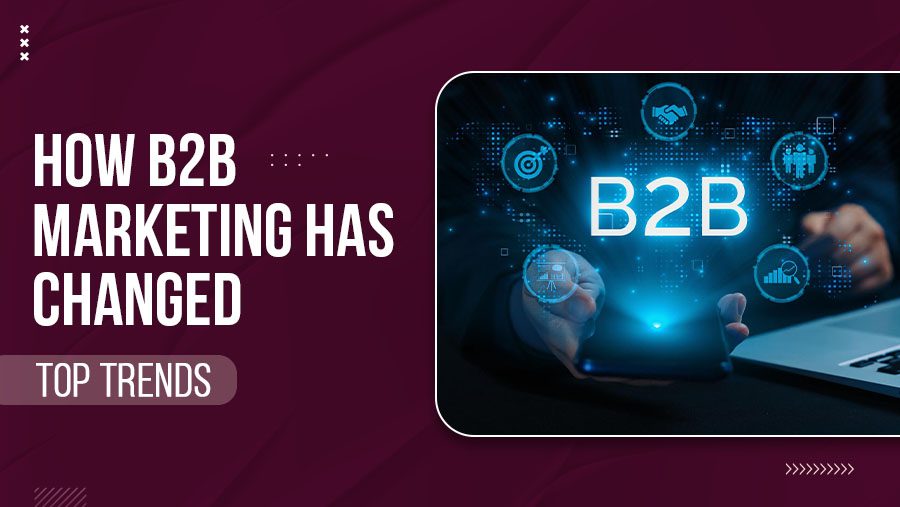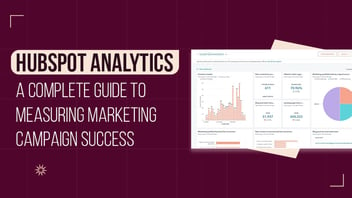
How B2B Marketing Has Changed: Top Trends Over The Years
B2B marketing was all about outreaching and customising the solution. However, in 2025 Data, automation and AI took over the storm. And today, all the B2B marketers rely on data to market themselves right!
We are diving headfirst into an automation and data era where automation tools and digital strategies are turbocharging business processes.
B2B marketing didn't just stop at digital transformation. In fact, there’s been constant marketing evolution in recent years.
Here are 10 ways explaining how B2B marketing has shape-shifted over time!
10 ways explaining how B2B marketing has shape-shifted

1. Data-backed & Real-time access to Buyer Behavior
Whether it's B2C or B2B, customers' buying behavior tends to evolve. It is a side effect of digital advancements.
Thus, marketers drew more towards understanding their buyer behavior over the years.
Let's see how B2B marketers adapt and deal with evolving B2B buyer behaviors:
- Self-Educated and Empowered Buyers: B2B buyers are increasingly self-educating before engaging with brands. Therefore, marketers focus on delivering them high-quality content such as:
- Thought leadership posts
- Whitepapers
- How-to or product demo videos
- Case studies
- Personalization and Customization: Buyers now expect personalized experiences. Thus, marketers need to focus more on providing tailored offers to meet prospects' specific preferences.
- Collaborative Decision-Making: B2B purchases often involve multiple stakeholders with unique priorities and perspectives. Thus, marketers have become careful in
presenting their offerings that please each stakeholder. - Social Conscious Buyers: Recent studies indicate that 63% of consumers prefer to purchase from purpose-driven brands that reflect their personal values and beliefs. Additionally, 90% of Gen Z consumers are concerned with social issues, which significantly influences their purchasing decisions. This shift underscores the importance for brands to integrate social causes into their marketing strategies to align with consumer expectations.
(Source: Marketing Scoop)
One of the examples is Pernod Ricard, a B2B E-Commerce company that led the #EngageResponsibly campaign. It was against hate speech and the spreading of misinformation on social media platforms.
2. Hyper-personalized B2B Marketing
Marketing via digital platforms has been here for more than a couple of decades now. However, digital marketing has seen a boost in recent years.
As of 2025, global digital advertising spending has reached approximately $650 billion, reflecting a significant growth trend in the industry (Source: Precedence Research). Some of the methodologies that gained popularity among global B2B marketers in 2025 are:

The only reason to adopt these B2B marketing strategies is to capture prospects' insights through the data-driven abilities that were never possible to this extent ever before.
The data-driven information helps you track a prospect’s behavior and intent. So it gives you a scope to hyper-personalize your messages and campaigns.
3. Rich, Relevant & Reliable Data Than Ever Before
B2B marketing today comprises measuring the campaign's effectiveness and optimizing it as on the results. Over the years, various data analytics technologies emerged to enhance target marketing. You may already know many of them, such as Google Analytics, HubSpot, and Salesforce.
These tools analyze website traffic, lead generation, and sales data in real-time!
Mainly, these tools provide information on the following:
- High-performing channels & campaigns
- Prospect pain point insights
- Most profitable target industries
4. The Sales And Marketing Alignment
Previously, the sales and marketing departments’ roles used to be different. But now, these two areas collaborate very closely to achieve the defined target.
However, such close collaboration between Sales & Marketing is only possible with Customer Relationship Management (CRM) systems in B2B.
In fact, many leading marketers like yourself use CRM to maintain a centralized customer/prospect database.
Thus, sales and marketing teams can share and identify qualified prospects that fulfill similar criteria.
For instance, your sales team can provide feedback on which industry they have the highest conversions in. And your marketing department can create customized plans accordingly.
5. B2B Lead Generation with Automated Solutions
Unlike earlier times, automation is key to streamlining operations in the current B2B marketing trends. The use of automated solutions is rapidly growing for:

You can find many of your competitors using automated technologies to deliver customized messages to their ideal clients. It saves time and reduces human labor. Moreover, it helps manage:
- Lead nurturing programs
- Segment email lists depending on consumer behavior
- Reports on the success of their marketing initiatives
6. Boosting Account-Based Marketing
Among many other B2B marketing trends and tactics, we saw a growth in Account-Based Marketing (ABM). This marketing tactic commonly helps concentrate on specific high-value clients. Further, it helps tailor marketing tactics to meet those clients' requirements.
ABM is nothing but a thorough analysis of suitable accounts, followed by personalized messaging creation. An effective ABM strategy provides:
- Increased revenue
- Improved client retention rates
- Produce leads of higher quality
7. Post-COVID B2B Marketing Online Trends
The aftermath of the COVID-19 pandemic, or what we can call it effect is unavoidable for both B2B and B2C marketing. As a marketers, we’re sure you can feel the drastic reduction in the social meetings with your clients. Moreover, B2B customers now utilize an average of ten channels throughout their purchasing journey, doubling from five channels (Source: McKinsey).

Thus, marketing approaches in the late 2020s look way different from early 2020s. Instead of social events, there is more inclination towards virtual meet and greets. B2B sales interactions are happening through virtual events by using some of the tools like Zoom, Teams, etc.
8. Inclined Interest in Dark Social Marketing
Nowadays, you can notice a renewed interest in Dark Social marketing in the B2B sector. Dark Social refers to social sharing through private channels, such as:
- Social Media DMs
- Slack
- Face-to-face conversations
- Private Forums and Communities
- Native Mobile Apps
- Text Messages (SMS)
- Social Media Groups & Communities
- Direct File Sharing
These channels are not easily trackable by traditional web analytics tools. Marketers may use:
- URL shorteners with tracking parameters,
- Implement sharing buttons on websites and apps
- Rely on referral patterns
-to estimate dark social traffic.
But, in comparison, dark social marketing is often more organic and authentic than content shared on public platforms. As such, people share the content because they genuinely find value in it. They don’t do it to project a certain brand image or gain social approval.
Interestingly, more than 80% of all business social shares are dark (Source: RadiumOne). Through this tactic, you’ll see marketers like yourself sharing and discussing information without the public scrutiny of social media platforms. Thus, it fosters a sense of intimacy between the customer and the brand.
9. From Sales-led To Value-led
Value-led Growth B2B marketing has risen, mainly in SaaS customer acquisition strategy. Hence, instead of sales pitches, products have become the primary drivers of the following:
- Customer acquisition
- Conversion
- Retention
Value-led growth creates a seamless and user-centric product experience. It empowers users to experience the value of the product directly. As a result, it encourages self-adoption and viral referrals of the product. One of the most famous examples is ChatGPT.
Value-led growth has the potential to stay longer in the B2B marketing space as it:
- Drives organic growth
- Reduces sales friction
- Increases customer satisfaction
10. Focusing on Custom Solutions
Custom Solutions has gained popularity because of its approach to understanding the customer’s concerns. It is a strategy that involves:
- Firstly, understanding customer pain points
- Then, delivering comprehensive solutions to address those challenges
Custom solutions go beyond a single product and offer a holistic marketing approach. It consists of interconnected products/services to meet diverse customers’ needs.
With this strategy, B2B marketing opens doors to provide end-to-end solutions. Custom solutions aims to achieve the following:
- Gain customer trust
- Build Long-term relationships
- Create value through a comprehensive solution ecosystem
Here we concluded the 10 ways B2B marketing has changed over the years. Now, let us move ahead to see current B2B marketing trends.
5 Burning Trends In B2B Marketing of 2025

Knowing the changes or updates in B2B digital marketing is not enough; you must also understand trends. So, here are some of the current trends in B2B marketing that you should be aware of:
1. LinkedIn is Gaining Importance In B2B Marketing
LinkedIn mainly serves businesses and professionals and so it secures the prime position when it comes to B2B Marketing trends.
89% of B2B marketers utilize LinkedIn for lead generation, highlighting its effectiveness in targeting specific audiences (Source: LinkedIn Editors). Several advantages of using LinkedIn for B2B marketing include:
- The capacity to build a credible brand identity.
- Networking skills with businesses and professionals.
- Targeting particular demographics using filters like job title, industry, firm size, etc.
- Lead generation on LinkedIn using the lead generation forms.
- Fostering connections with potential partners and customers through platform participation.
2. Competition Is Rising In B2B Content Distribution
In 2025, Content distribution marketing attracts and engages potential customers with valuable content sharing. 73% of B2B marketers use content marketing as a part of B2B marketing strategy (Source: Content Marketing Institute Report). Thus, the competition is only growing higher. Some benefits of B2B content marketing are:
- Allows you to establish a brand as a thought leader across the industry
- Increases website traffic and search engine rankings
- Generates leads through content downloads and sign-ups
- Builds customer trust and loyalty through valuable content
- Repurposes content for use in multiple channels and platforms
3. Collaboration With Influencers
Influencer marketing entails collaborating with people with a sizable following on social media or other platforms to advertise your product or service. It raises brand awareness in the best way possible. The following are some advantages of influencer marketing in B2B:
- Utilizing the influencer's following to reach new audiences.
- Gaining credibility and trust through influencer endorsement.
- Generating leads using the influencer's call to action.
- Adding to the number of followers and interactions on social media.
- Establishing connections with influential people to work together in the future.
4. Using Digital Platforms & Channels Effectively
The recent growth of digital marketing directly influences B2B marketing’s increased spending on digital channels. Some of the popular channels include:
- Email marketing
- Social media advertising
- LinkedIn advertising
- Content syndication
- Search Engine Optimization (SEO)
Some benefits of shifting marketing approaches to digital channels are:
- Ability to track, analyze, and measure the efficacy of campaigns in real time.
- Targeting specific audiences through various digital channels.
- Building a stronger online presence and brand image.
- Generating leads through targeted campaigns and offers.
5. Use of Intent-data for Cold Outreach
You've probably noticed that intent-driven cold email marketing campaigns are rising in the B2B marketing. It focuses on creating personalized and compelling emails and sending them to prospects unaware of your brand. In fact, it’s a great tool to reach out to prospects and create meaningful connections that lead to conversions nowadays.
Some popular cold email elements are in trend:
- Custom text, numbers, or questions on subject lines
- Multi-point personalization of email content has helped with 6x higher transaction rates, 29% higher open rates, and 41% higher click-through rates. (Source: Salesforece)
- Mobile-friendly cold email templates.
- Time-sensitive methods (Monday and Tuesday and 1 to 3 PM to send cold emails) to send cold emails)
- Up to 5 targeted cold email follow-ups that highlight:
- Customer testimonials
- Case studies
- Limited edition offers
- Gentle breakup email
6. Risen Engagement on Video Marketing
In 2025, video marketing has become an effective B2B marketing trend. With decision-makers pressed for time, video offers a concise, engaging way to deliver complex information—whether it’s a product demo, customer testimonial, or thought leadership snippet.
According to recent research, 91% of businesses use video as a marketing tool, and 89% of marketers report that video gives them a positive ROI (Source: Wyzowl).
B2B companies are increasingly leveraging short-form videos for LinkedIn, interactive webinars, and personalized video outreach in ABM campaigns. Not only does video improve engagement and retention, but it also humanizes the brand and builds trust faster in a remote-first world.
Scale up Your B2B Marketing With Revnew!
We've delved into some pretty exciting shifts within the realm of B2B marketing. Now, here's a golden ticket – team up with the pros. Revnew has got this all-in-one solution for your marketing goals. Our experts? Oh, they're like your marketing strategy's mentors.




